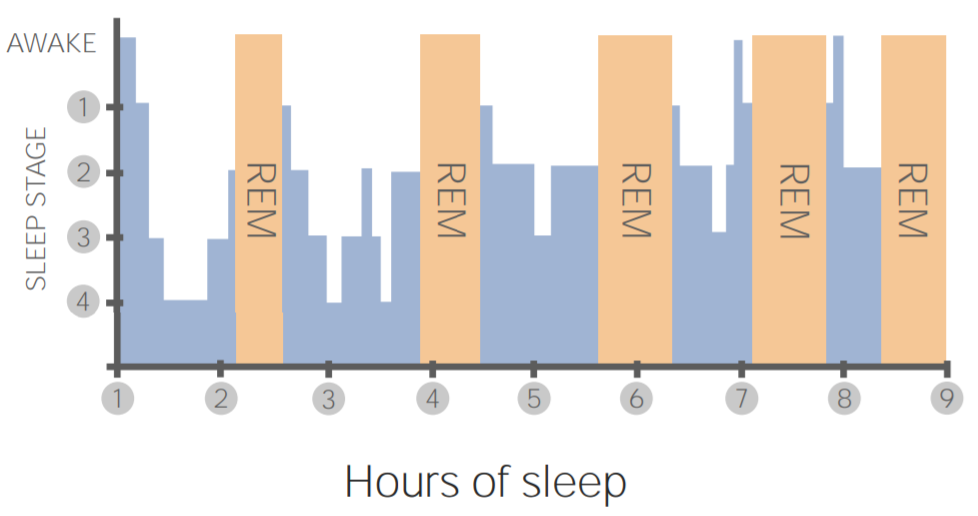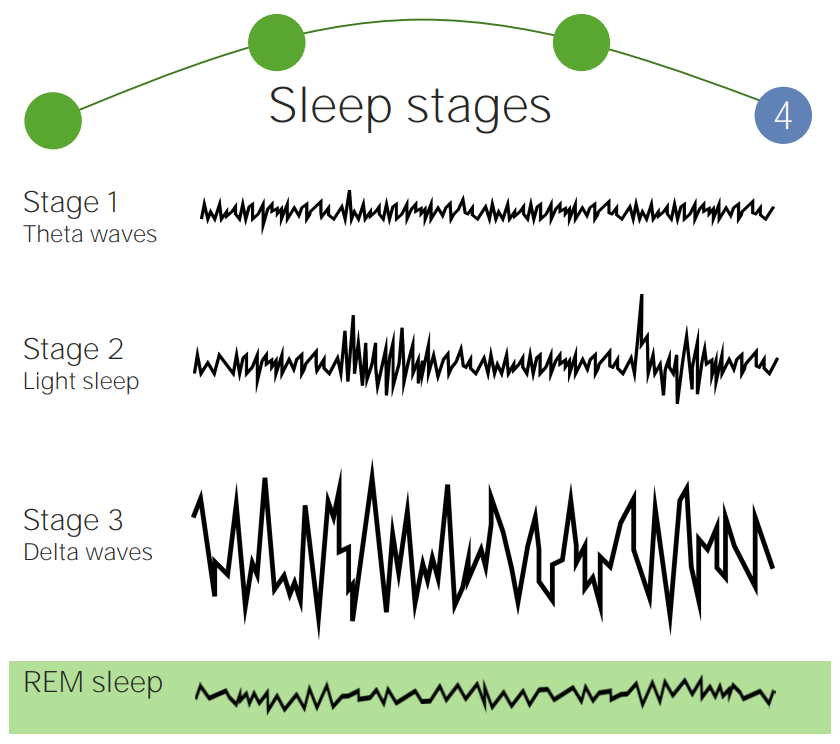Sleep is a reversible phase of diminished responsiveness, motor Motor Neurons which send impulses peripherally to activate muscles or secretory cells. Nervous System: Histology activity, and metabolism. This process is a complex and dynamic phenomenon, occurring in 4–5 cycles a night, and generally divided into non–rapid eye movement (NREM) sleep and REM sleep stages. NREM sleep, consisting of 3 stages, represents the period of transition from wakefulness, somnolence, and then deep sleep. REM sleep is characterized by rapid irregular eye movement, but with voluntary muscle atonia Atonia Flaccidity, no resistance to passive motion Neurological Examination. The sleep stages and associated disorders are studied through the use of polysomnography, a multimodal test evaluating the brain Brain The part of central nervous system that is contained within the skull (cranium). Arising from the neural tube, the embryonic brain is comprised of three major parts including prosencephalon (the forebrain); mesencephalon (the midbrain); and rhombencephalon (the hindbrain). The developed brain consists of cerebrum; cerebellum; and other structures in the brain stem. Nervous System: Anatomy, Structure, and Classification waves, along with ocular and motor Motor Neurons which send impulses peripherally to activate muscles or secretory cells. Nervous System: Histology activities. Sleep disorders can be primary (which do not stem from any health problem) or can be attributable to underlying conditions or medications.
Last updated: Nov 5, 2024
Sleep is a reversible phase of diminished responsiveness, motor Motor Neurons which send impulses peripherally to activate muscles or secretory cells. Nervous System: Histology activity, and metabolism. The purpose of sleep is poorly understood; however, there are multiple theories:

Stages of healthy sleep:
Sleep is divided into non–rapid eye movement (NREM; blue bars) and REM (orange bars) stages in each sleep cycle. Around 4–5 sleep cycles occur throughout the night, with each cycle averaging 90–120 minutes.
Generally, an adult is awake for ⅔ of the day. The body relaxes before going through different stages of sleep.
| Stage | Description | EEG EEG Seizures wave | |
|---|---|---|---|
| Awake | Eyes open | Person is alert and active. | Beta waves |
| Eyes closed |
|
Alpha waves | |
| NREM sleep | Stage N1 |
|
Theta waves |
| Stage N2 |
|
|
|
|
Stage N3 (deep sleep, or slow-wave sleep) |
|
Delta waves | |
| REM sleep (stage R) |
REM sleep (dream state) |
EEG
EEG
Seizures:
|
Beta waves (similar wave to awake state, but with atonia Atonia Flaccidity, no resistance to passive motion Neurological Examination) |
The following mnemonic summarizes the sleep waves in the different stages of sleep:
“At night, BATS Drink Blood”

Sleep stages and EEG waves:
Stage N1 shows theta waves.
Stage N2 also has theta frequency but has distinct features: sleep spindles and K complexes.
Stage N3 (deep sleep) is characterized by delta waves.
During REM sleep, sawtooth waves (beta waves similar to wakeful state) are seen, with electromyogram exhibiting atonia.
NREM sleep:
REM sleep:
| Substances | Findings |
|---|---|
| Selective serotonin reuptake inhibitors Selective Serotonin Reuptake Inhibitors Serotonin Reuptake Inhibitors and Similar Antidepressants |
|
| Benzodiazepines Benzodiazepines Benzodiazepines work on the gamma-aminobutyric acid type A (GABAA) receptor to produce inhibitory effects on the CNS. Benzodiazepines do not mimic GABA, the main inhibitory neurotransmitter in humans, but instead potentiate GABA activity. Benzodiazepines |
|
| Carbamazepine Carbamazepine A dibenzazepine that acts as a sodium channel blocker. It is used as an anticonvulsant for the treatment of grand mal and psychomotor or focal seizures. It may also be used in the management of bipolar disorder, and has analgesic properties. First-Generation Anticonvulsant Drugs |
|
| Barbiturates Barbiturates A class of chemicals derived from barbituric acid or thiobarbituric acid. Many of these are gaba modulators used as hypnotics and sedatives, as anesthetics, or as anticonvulsants. Intravenous Anesthetics |
|
| Monoamine oxidase Oxidase Neisseria inhibitors |
|
| Tricyclic antidepressants Tricyclic antidepressants Tricyclic antidepressants (TCAs) are a class of medications used in the management of mood disorders, primarily depression. These agents, named after their 3-ring chemical structure, act via reuptake inhibition of neurotransmitters (particularly norepinephrine and serotonin) in the brain. Tricyclic Antidepressants |
|
| Alcohol |
|